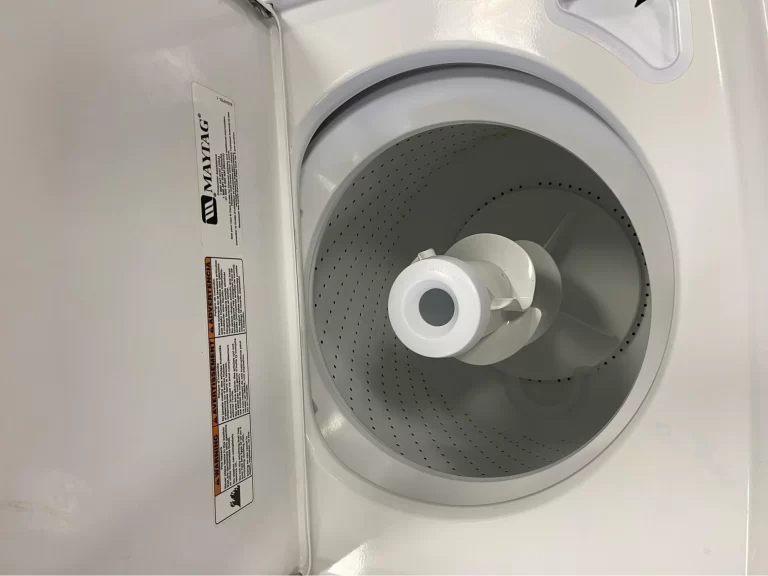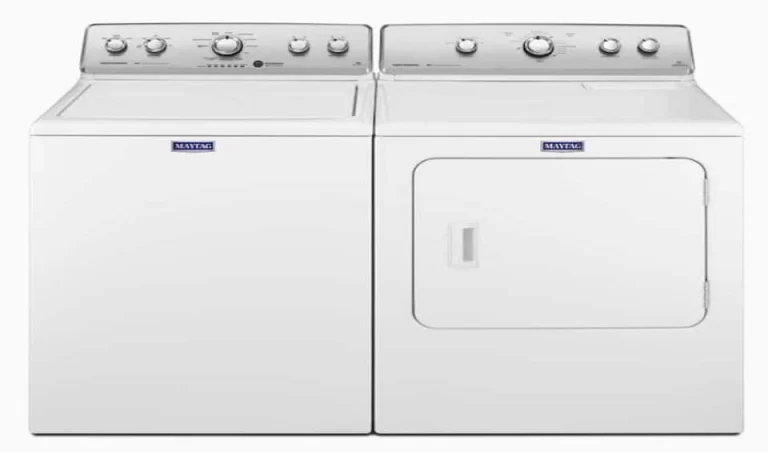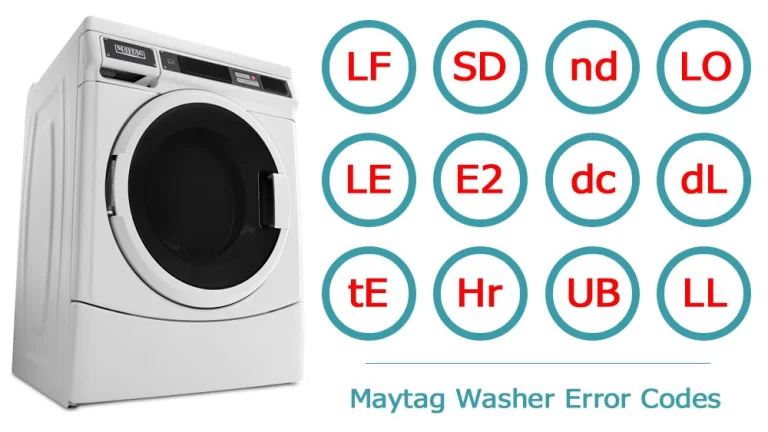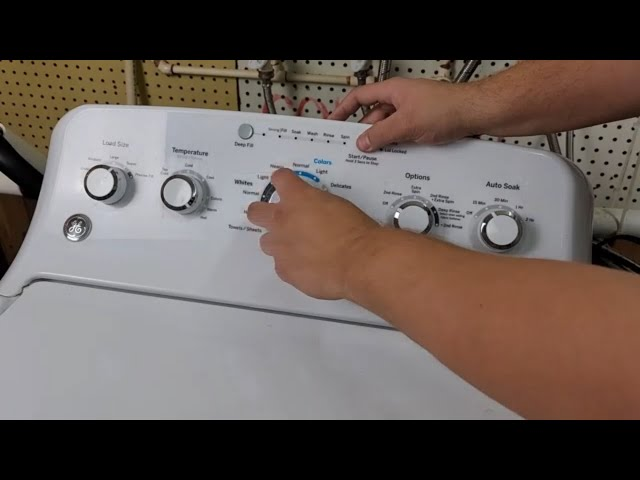The washing machine, a cornerstone of modern household convenience, has witnessed remarkable advancements over the years. One pivotal feature that has undergone significant evolution is the machine’s spin speed. The ability to adjust and optimize this spin speed has empowered users to cater to diverse fabric types, ensuring both efficient cleaning and garment longevity.
A washing machine typically spins at speeds ranging from 300 to 1,400 RPM (revolutions per minute). The exact speed varies based on the machine’s model, settings, and the type of fabric being washed. Modern machines often allow users to select their preferred spin speed to suit different laundry needs.
History and Evolution of Washing Machine Spin Speeds
The tale of washing machine spin speeds is intertwined with the history of the washing machine itself. As we journey through time, one can witness the fascinating evolution from humble beginnings to the advanced technological marvels we use today.
Ancient Innovations
Before mechanical washing machines came into existence, laundry was an arduous task involving manual scrubbing, beating, and rinsing. Early civilizations devised various methods, such as using wooden planks, rocks, and even feet to clean fabrics. The most ancient washing “machines” were essentially water bodies like rivers or lakes.
18th Century: The Dawn of Mechanical Assistance
By the late 18th century, the first rudimentary washing machines began to emerge. The initial designs, like the wooden drum machine invented by H. Sidgier of Great Britain in 1782, involved hand-crank mechanisms. These machines were revolutionary for their time but had no spinning mechanism, relying instead on manual wringing post-wash.
19th Century: The Age of Innovation
The 1800s were a period of rapid development. The US, in particular, saw a slew of patents being filed for washing machine designs. James King’s 1851 model introduced a drum-like mechanism, setting the stage for future spin developments. However, the real game-changer came in the late 19th century when Alva J. Fisher created the Thor – widely regarded as the first electric washing machine. Still, these early electric models didn’t possess the high RPMs we associate with modern machines.
20th Century: Rise of the Spin Cycle
By the 1950s, washing machines started becoming common household items, especially in the western world. As designs evolved, the importance of spin cycles became clear. These cycles were introduced to replace the draining process and manually wringing out clothes. The early electric machines had spin speeds of around 300-500 RPM. But as technology advanced and the benefits of faster spin cycles became evident – primarily better water extraction and shorter drying times – the RPMs started to increase. By the 1990s, models boasting 1000 RPM and above began to appear.
21st Century: Pursuit of Efficiency
The turn of the century saw a shift towards energy efficiency and fabric care. This era marked the appearance of machines that could spin at very high speeds – some models even reaching 1600 RPM. However, the focus wasn’t just on speed but also on ensuring garments weren’t damaged. As a result, many modern machines come with variable spin speeds to cater to different fabric types. Advanced sensors and algorithms now allow some washers to determine the optimal spin speed based on the load, ensuring both efficiency and care.
The Basics: Understanding Spin Speeds
In the realm of washing machines, spin speed plays a pivotal role in the efficiency and effectiveness of the laundry process. While the concept might seem straightforward, understanding its intricacies can provide valuable insights for users, ensuring optimal performance and care for their garments. Here’s a deep dive into the basics of spin speeds:
Defining RPM
The spin speed of a washing machine is commonly measured in Revolutions Per Minute, or RPM. This denotes how many times the drum completes a full rotation within a 60-second timeframe. For instance, if a washing machine has a spin speed of 800 RPM, it means the drum rotates 800 times in one minute.
Range of Spin Speeds
Modern washing machines offer a broad range of spin speeds, catering to diverse laundry requirements:
- Low Spin Speeds (300-500 RPM): Typically found in older models or machines designed for delicate cycles, these speeds are gentle on fabrics but leave more moisture in the clothes.
- Medium Spin Speeds (500-900 RPM): This is a common range for many household machines, striking a balance between fabric care and moisture removal.
- High Spin Speeds (900-1600 RPM): Mostly found in advanced or industrial models, these speeds extract maximum moisture, reducing drying time but may be harsher on delicate fabrics.
Factors Influencing Spin Speed Selection
Several elements determine the optimal spin speed for a wash:
- Fabric Type: Delicate fabrics like silk or lace require lower RPMs, while more robust fabrics like denim can withstand and benefit from higher RPMs.
- Load Size: Smaller loads might not need as high a spin speed as fuller loads. Overloading, however, can result in an uneven distribution and a potentially damaging spin.
- Detergent Type: Some detergents are formulated to work best at specific RPM ranges, ensuring effective cleaning and rinsing.
- User Preference: Some users might prioritize quick drying times and opt for higher RPMs, while others might lean towards fabric longevity and select a lower spin speed.
Interplay with Other Cycles
The spin speed is often integrated with other machine cycles. For example, during the rinse cycle, a moderate spin might be employed to remove detergent, followed by a higher spin at the end to extract moisture.
A Balancing Act
It’s essential to remember that while higher RPMs offer faster drying times, they might not always be the best choice. Striking the right balance between spin speed, fabric care, and energy consumption is key to optimizing the laundry process.
The Science Behind Spinning

To truly appreciate the efficiency and brilliance of our washing machines, it’s essential to understand the underlying science that powers the spin cycle. Far from a simple rotation, the spin is a culmination of physics and engineering working in tandem to achieve optimal water extraction and garment care. Here’s a deep dive into the science behind the spin.
Centrifugal Force: The Heart of the Spin
At the core of the spinning mechanism is the concept of centrifugal force. When the washing machine drum rotates, it creates a force that pushes objects (in this case, wet clothes) outwards towards the drum’s walls. This outward force effectively squeezes water out of the clothes and into the machine’s drain. The faster the drum spins, the stronger the centrifugal force exerted on the garments.
Balancing the Load: Physics in Play
Ever noticed how an unbalanced washing machine can become excessively noisy and even move during the spin cycle? This is due to uneven distribution of clothes inside the drum, causing an imbalance. When the drum’s center of mass doesn’t align with the machine’s rotation axis, it results in vibrations. Modern washers often have sensors that detect such imbalances and will either attempt to redistribute the load by agitating before a spin or adjust the spin speed to reduce vibrations.
Water Extraction Efficiency
The efficiency of water extraction is directly proportional to the RPM of the machine. A study conducted by the University of Manchester found that doubling the spin speed could extract up to 10% more water from clothes. This, in turn, reduces drying time, which can lead to significant energy savings, especially for those using electric dryers.
Air Flow Dynamics
Beyond just centrifugal force, the design of the drum holes and the machine’s overall airflow play a role in drying the clothes. As the drum spins, air circulates through the drum’s holes, aiding in evaporating some of the moisture from the clothes. This is why even at lower spin speeds, some drying effect is achieved.
Safety Mechanisms: Preventing Excessive Centrifugal Forces
While higher RPMs can be beneficial for drying, they also generate more significant centrifugal forces, which could potentially damage the machine or the fabrics. Hence, washing machines are engineered with safety mechanisms that prevent them from spinning at speeds that could be hazardous. Many modern machines have reinforced drums and shock absorbers to handle these forces.
Benefits of Higher Spin Speeds

There are undeniable benefits to faster spins:
Washing machines are one of the hallmarks of modern convenience, and their evolution over the decades has produced machines that are more efficient and user-friendly. One significant development in this arena is the increase in spin speeds. While higher RPMs (revolutions per minute) might initially seem like just a technical upgrade, they offer a multitude of tangible benefits for the user. Let’s delve into the advantages of higher spin speeds:
1. Quicker Drying Times
The primary and most noticeable benefit of higher spin speeds is the reduced moisture content in clothes post-wash. Faster spins utilize centrifugal force more effectively, extracting a larger amount of water. This means clothes come out less damp, leading to reduced drying times, whether you’re air-drying or using a tumble dryer.
2. Energy and Cost Savings
With clothes emerging less wet from the wash, tumble dryers require less time and energy to complete the drying process. According to the U.S. Department of Energy, more efficient spin cycles can lead to energy savings, which not only benefits the environment but also translates to cost savings on energy bills.
3. Efficient Use of Detergents
Higher spin speeds can result in more effective rinsing. The rapid movement ensures that detergent residues, which might stick to fabrics at lower RPMs, are thoroughly flushed out, ensuring that garments are free from potential allergens or irritants.
4. Time Efficiency for Users
For those with tight schedules, every minute counts. Higher spin speeds can reduce the overall laundry time, especially when combined with faster drying times. This means less waiting around and more time for other activities.
5. Reduced Dependency on Dryers
In regions or seasons where outdoor drying is feasible, higher spin speeds can sometimes eliminate the need for mechanical drying altogether. Clothes that have undergone a high RPM spin often dry quite rapidly when hung outside, especially in sunny or windy conditions.
6. Enhanced Washer Lifespan
Though it might seem counterintuitive, in some cases, machines designed for higher spin speeds can have a longer lifespan. These machines are typically constructed with robust materials and components that can withstand the forces generated by high RPMs, potentially leading to fewer maintenance issues in the long run.
7. Space Efficiency in Homes
For homes that rely solely on indoor drying, especially in smaller living spaces, higher spin speeds can be a boon. Clothes that dry faster mean less clutter, as drying racks or lines are cleared more quickly, freeing up living space.
Drawbacks and Limitations
While higher spin speeds in washing machines offer an array of benefits, it’s essential to recognize that they also come with certain drawbacks and limitations. As with any technological advancement, it’s crucial to weigh the pros against the cons. Let’s delve into some of the potential challenges and limitations associated with higher RPMs (revolutions per minute) in washing machines.
1. Wear and Tear on Clothes
One of the most common concerns with higher spin speeds is the increased wear and tear on fabrics. Delicate items, especially those made of silk, lace, or thin cotton, can be at risk of damage, stretching, or even tearing when subjected to very high RPMs.
2. Noise Levels
Faster spinning often results in increased noise levels. This can be disruptive, especially in homes with open floor plans or if the washing is done during quieter hours. Vibrations from the machine can also resonate more prominently, leading to potential disturbances.
3. Imbalance and Vibrations
Higher spin speeds can exacerbate issues of imbalance in the washing load. If clothes are not evenly distributed inside the drum, the machine can vibrate excessively, leading to potential movement or even damage to the machine or surrounding areas.
4. Energy Consumption
While faster spin speeds can lead to savings in dryer energy use, the washing machine itself might consume more power during a high RPM spin, especially if the spin cycle duration is extended.
5. Machine Wear and Tear
Consistently using the highest spin speeds can put additional strain on the washing machine’s components, such as the motor, bearings, and drum. Over time, this can lead to a reduced lifespan of the appliance or necessitate more frequent repairs.
6. Detergent Residue Challenges
While efficient spin speeds can aid in removing detergent residues, paradoxically, if the rinse cycle isn’t thorough, higher RPMs can sometimes compact residues onto fabrics, making them harder to remove in subsequent washes.
7. Limitations for Bulky Items
Items like comforters, blankets, and large towels often don’t fare well with very high spin speeds. These bulky items can become too compacted or even tangled, leading to inefficient washing and rinsing.
8. Cost Implications
Washing machines capable of very high spin speeds are often positioned as premium products. This means the initial investment for such a machine might be considerably higher than for models with more moderate RPM capabilities.
Choosing the Right Spin Speed for Different Fabrics

Each fabric has its unique composition and weave, making it essential to select the appropriate spin speed during laundry to ensure garment longevity and optimal cleaning. An incorrect spin speed could lead to fabric damage, inadequate cleaning, or excessive wear and tear. Let’s explore how to choose the right spin speed based on different fabric types:
1. Cotton and Linen
Properties: Both cotton and linen are durable natural fibers, and garments made from them can often handle higher spin speeds.
Recommended Spin Speed: 800-1400 RPM, depending on the weight and sturdiness of the garment. Bed linens and towels might benefit from higher speeds for optimal water extraction, while lighter cotton garments may require a moderate speed.
2. Synthetic Fabrics (Polyester, Nylon, Acrylic)
Properties: Synthetic fibers are generally more resilient to shrinkage but can be affected by high temperatures and excessive spinning.
Recommended Spin Speed: 600-900 RPM. This range helps ensure that the synthetic garments maintain their shape and do not suffer from fiber damage.
3. Wool and Cashmere
Properties: Wool and cashmere are delicate natural fibers that can shrink or become misshapen with excessive agitation.
Recommended Spin Speed: 400-800 RPM. Always use a dedicated wool or delicate cycle if available, as these settings are tailored for gentle handling.
4. Silk
Properties: Silk is a delicate fiber that can be easily damaged by mechanical action and is prone to water spots.
Recommended Spin Speed: 300-600 RPM. Some machines come with a specific silk setting, which is best for silk garments.
5. Denim
Properties: Denim, especially when densely woven, is robust and heavy. However, it can also be prone to creasing if spun excessively.
Recommended Spin Speed: 800-1100 RPM. While denim can withstand higher RPMs, a moderate speed will prevent excessive wrinkling and potential fabric weakening.
6. Activewear and Sportswear
Properties: Often made of technical synthetic blends designed for moisture-wicking and flexibility.
Recommended Spin Speed: 600-900 RPM. These fabrics benefit from a balanced spin that extracts moisture without compromising elasticity.
7. Delicates and Lingerie
Properties: These can be made of various materials, including lace, thin cotton, and synthetic blends. They are often embellished or have fine detailing.
Recommended Spin Speed: 300-600 RPM. A gentle spin is crucial to preserving the integrity and detailing of these items.
8. Rayon/Viscose
Properties: Though derived from natural cellulose, rayon behaves more like a synthetic and can easily misshapen when wet.
Recommended Spin Speed: 500-800 RPM, with caution on the higher end to prevent the garment from losing its shape.
Tips for Users
Navigating the intricacies of washing machines and spin speeds can be a bit overwhelming, especially with the multitude of settings available on modern appliances. However, armed with a few essential tips, users can harness the full potential of their washing machines while ensuring the longevity and care of their garments. Here are some invaluable pointers:
1. Always Check Care Labels
Before deciding on a spin speed, always consult the care label on your garment. This tag provides manufacturer-recommended washing and drying instructions that are tailored for the specific fabric and design of the item.
2. Distribute Clothes Evenly
Ensure clothes are evenly distributed in the drum before starting a wash. An imbalanced load can cause the washing machine to vibrate excessively, which may affect its efficiency and can even lead to potential damage.
3. Use Lower Spin Speeds for Mixed Loads
When washing a mix of fabrics, it’s safer to choose a moderate or lower spin speed to accommodate the most delicate item in the load.
4. Consider Load Size
While it might be tempting to wash a small number of items using a high spin speed for faster drying, a very light load might not distribute evenly, leading to imbalances. Conversely, overloading can reduce the efficiency of the spin cycle.
5. Utilize Spin-Only Cycles
If you feel that your clothes are still too damp after a wash, use the spin-only cycle. This allows for additional water extraction without going through another full wash cycle.
6. Skip High Speeds for Fragile Items
Delicate items, especially those with embellishments, lace, or intricate designs, are best spun at lower speeds to prevent potential damage or distortion.
7. Regular Maintenance
Periodically inspect your washing machine for wear and tear, especially on parts involved in spinning, such as the belt and drum. Regular maintenance ensures the machine operates at its best, offering optimal spin performance.
8. Understand Your Machine
Take time to read the user manual. Different machines have unique features, and understanding the specific spin settings and features of your appliance can enhance your washing experience.
9. Reduce Spin Speed for Less Creasing
If you’re concerned about wrinkles, a lower spin speed can help. While it may leave clothes slightly damper, it can also reduce the severity of creases, making ironing easier.
10. Reevaluate for New Purchases
If you buy a new washing machine, don’t assume that the optimal spin speed for your old machine is the same for the new one. Newer models may have different specifications, features, and recommendations.
FAQs
1. Why is spin speed important in a washing machine?
Spin speed affects how dry clothes are after washing, which can influence drying times and energy usage. Higher spin speeds extract more water, reducing the time and energy needed for drying.
2. Can I adjust the spin speed on all washing machines?
While many modern washing machines offer adjustable spin speeds, some older or basic models may have fixed speeds. Always refer to the user manual or machine settings to see the available options.
3. Is it safe to always use the highest spin speed?
Not necessarily. While higher spin speeds can dry clothes more efficiently, they may not be suitable for delicate fabrics or mixed loads. Consistently using the highest speed can also lead to wear and tear on both the machine and clothes.
4. What should I consider when selecting a spin speed?
When choosing a spin speed, consider the type of fabric, the load size, and the garment care instructions. It’s essential to balance efficient drying with garment care to ensure the longevity of your clothes.
5. My washing machine vibrates excessively during the spin cycle. Why?
Excessive vibration can be due to an imbalanced load where clothes are unevenly distributed in the drum. It could also indicate wear and tear on the machine’s parts or the need for leveling the appliance. Ensure clothes are evenly spread and check the machine for any maintenance needs.
Conclusion
Understanding and harnessing the power of spin speeds in washing machines is more than just a technical endeavor; it’s a journey into optimizing garment care and household efficiency. By appreciating the intricacies of different fabrics, the science behind spinning, and the potential benefits and limitations, users can elevate their laundry experience. As with any tool, it’s the judicious and informed use of washing machine spin speeds that truly brings about a harmonious blend of convenience and care.






